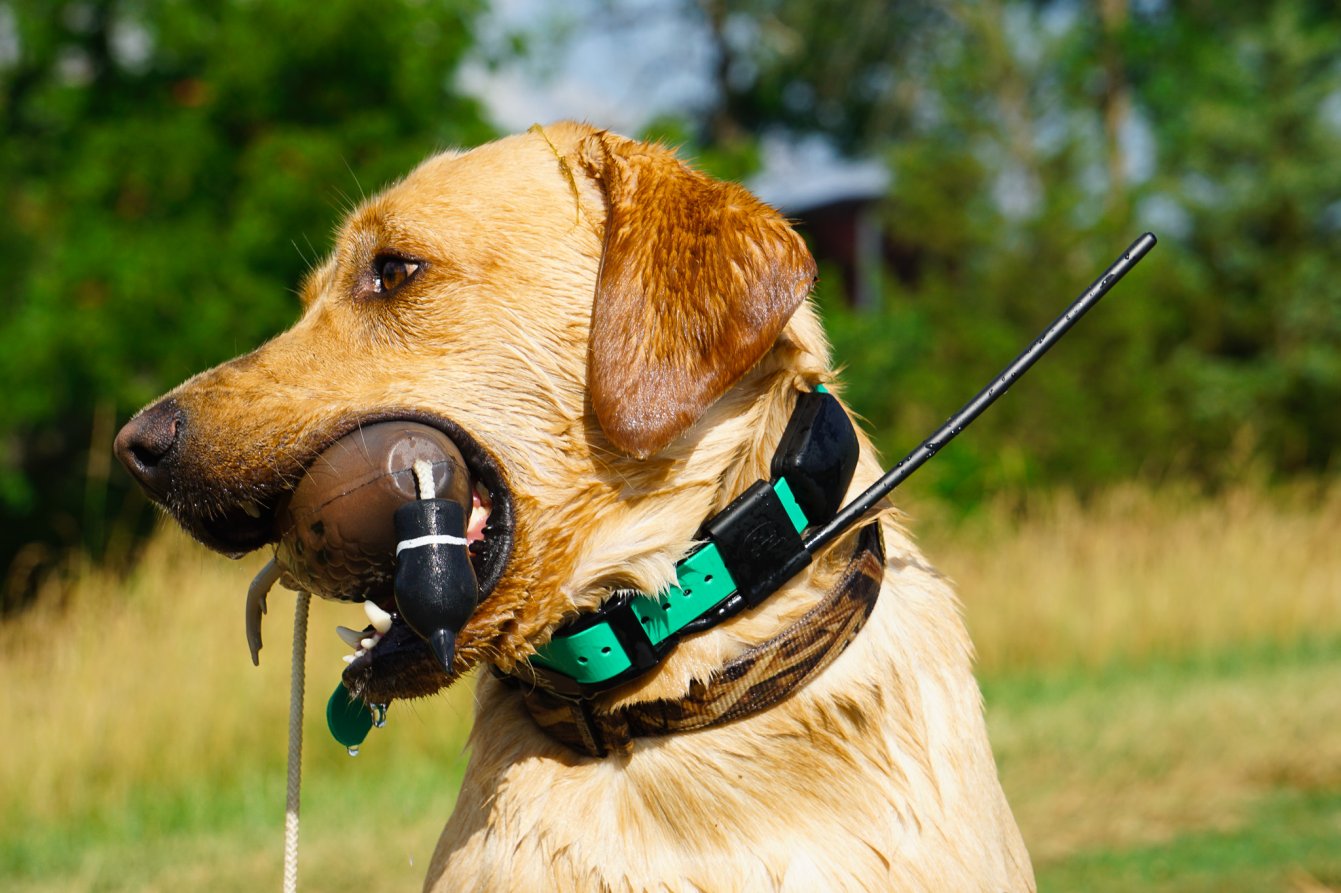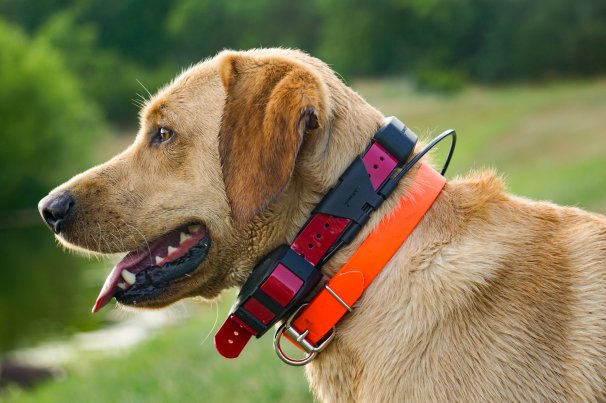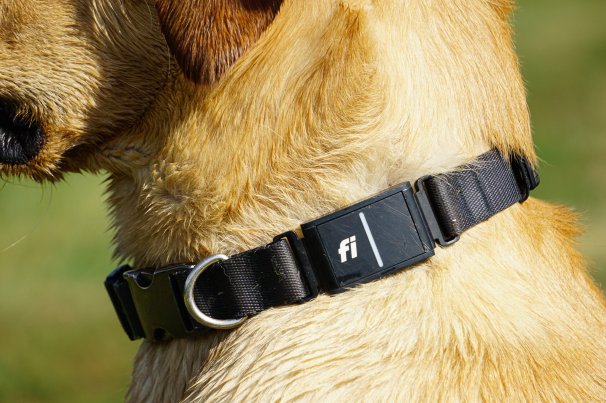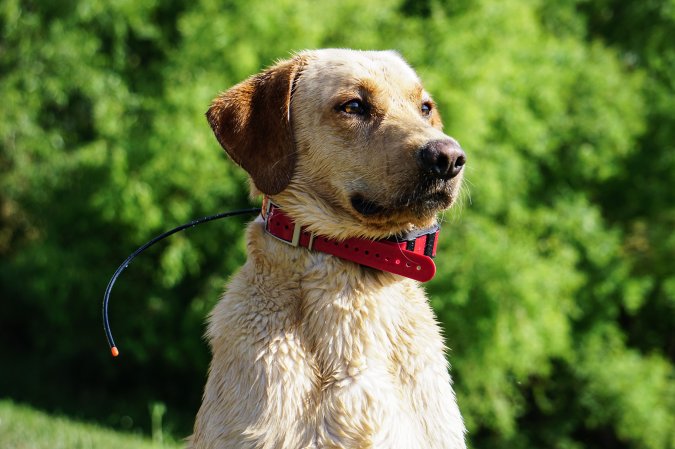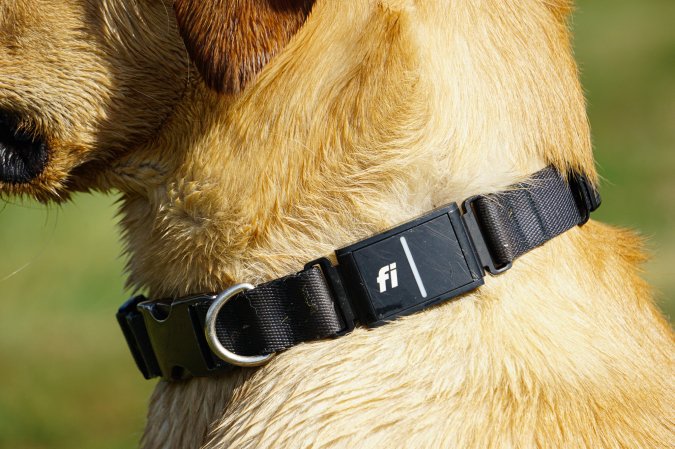We may earn revenue from the products available on this page and participate in affiliate programs. Learn More ›
There are few worse feelings than not knowing where your dog is; GPS dog collars can fix that. It’s common to lose sight of your pup when hunting thick cover, and it’s guaranteed when you’re running pointers or a far-ranging pack of hounds. But it’s also all too common for dogs to get separated from you and, in the worst cases, truly lost.
The best way to monitor your dog while he’s off-leash is to invest in a tracking collar. These are typically divided into two categories: purpose-built GPS collars for hunting and working dogs, and everyday trackers more commonly used to keep tabs on the family pet. Both types of collars have their advantages, and that’s why I tested some of the best GPS dog collars that are available right now. As more collars become available for testing this summer, we’ll evaluate them and add them to this review. Here are our top picks:
- Most Accurate: Garmin TT15x
- Best Value: SportDog Tek 1.5
- Best for Everyday: Fi Series 3
How I Tested the Best GPS Dog Collars

I conducted this test in rural, suburban, and urban environments to evaluate each collar’s cellular and GPS coverage, as well as potential interference from both terrain and technology. Bird dog training sessions were conducted with my 2-year-old retriever, Hatchet, in tall grass, timber, farm ponds, and steep terrain, as well as in suburban neighborhoods and a remote U.S. Forest Service tract.
I put the collars on Hatchet and enlisted a buddy to run him up to a mile away, then verified that track with the handheld and smartphone readings to check tracking accuracy. The GPS collars were also placed at known distances (100 yards and 200 yards, measured with a laser rangefinder) and compared to their handheld location tracking. In addition to running Hatchet through repeated water retrieves in both freshwater and saltwater with each collar, they were submerged in a tub of freshwater for 30 minutes to test water resistance (all the collars in this test passed without incident). The individual features of each collar—lights, battery life, e-collar training functionality, perimeter alerts, etc.—were also tested in the field.

Hatchet and I have been training together and with professionals for two years. He normally wears a SportDog 825X e-collar during training and hunting, and was comfortable with even the heaviest GPS collar he wore in this test. He’s close-ranging on upland hunts but allowed to wander barnyards and surrounding fields whenever we’re in rural areas, where he constantly works cover and occasionally chases rabbits and other critters out of sight.
Best GPS Dog Collars: Reviews and Recommendations
Best Overall: Garmin TT 15X
The Garmin TT15X is an accurate tracking and training collar with all the bells and whistles. It’s compatible with a variety of Garmin’s handheld devices (sold separately); we tested the TT15X with the new Alpha 300i handheld.
Key Features
- Collar dimensions: 3.5 x 1.75 x 1.85 inches
- Collar strap: 1-inch wide, 27 inches long
- Total collar weight: 10.3 ounces (tester measured)
- Handheld: Not included; compatible with Garmin Alpha models, Astro 430, Pro 550 Plus; tested with Alpha 300i, weighs 10.4 ounces (tester measured)
- Battery type: Rechargeable lithium-ion; user-replaceable
- Charging cord: USB, proprietary
- Advertised battery life: Up to 80 hours
- Advertised range: 9 miles
- Waterproof rating: Up to 10 meters (1 ATM)
- Lights: Beacon LED with multiple settings, controlled remotely
- Rescue mode: Yes
- Sleep mode: Yes, with certain handheld devices
- E-collar training: Yes; 18 stimulation levels (continuous and momentary), plus tone and vibration
- Includes: Standard and long-range antenna, vehicle power cable
Pros
- Most accurate tracking
- Easy e-collar access while tracking
- Infinitely customizable for your hunting style
- Compatible with Garmin watches
Cons
- Requires a separate purchase of a handheld device
- Bulkiest collar
Garmin is unrivaled in its Iridium satellite-supported InReach devices that many hunters already rely on in the backcountry, and its TT15X GPS dog collar is no exception. While bird hunters and houndsmen will appreciate the feature-packed TT15X (with an advertised 9-mile range in the best conditions), this collar would also work well for a dedicated blood tracking dog and his handler, thanks to its waypoint functionality and detailed tracks. The TT15x’s GPS was the clear accuracy winner, with nuanced tracking that showed my dog’s every move. The GPS tracking interface is info-packed and intuitive, with multiple displays to track your dog, including maps.

In fact, there’re so many features packed into the TT15X that it can take some getting used to, with everything from Garmin watch pairing and SOS functionality with an InReach subscription to proximity alarms and competition timers. Customization is available for nearly any feature your pup might need, including GPS collar lights, point/treed alerts, e-collar stimulation buttons, and more.
The GPS unit on the collar was the bulkiest and heaviest in the test (though it’s comparable in design to the SportDog Tek 1.5, and has been updated with the TT 25 collar model). But that’s a minor gripe about an otherwise stellar unit that can track your dog anywhere he might go. The bottom line: If you have the budget for an ongoing subscription and a separate handheld device, the Garmin TT15X is one of the best GPS dog collars on the market.
Best Value: SportDog Tek 1.5LT
This no-nonsense GPS tracking collar from SportDog includes both tracking and e-collar training capabilities.
Key Features
- Handheld included
- Multiple dog tracking: Up to 12 collars
- Advertised range: Up to 7 miles
- Size: Fits dogs 8 pounds or larger with neck sizes 10.75 – 23 inches
- E-collar: Yes; 99 stimulation levels (momentary, continuous, rising), plus tone and vibration
- Total collar weight: 9 ounces (tester measured)
- Handheld weight: 7.3 ounces (tester measured)
- Waterproof: Handheld is submersible up to 5 feet; collar up to 25 feet
- Rechargeable lithium-ion batteries
- Charging cord: USB, proprietary
- Advertised battery life: GPS collar charges in 4 hours and lasts 24 hours per charge; handheld charges in 2 hours; lasts 20 hours per charge (tester confirmed)
- Includes lanyard
Pros
- Handheld included
- Easy to use out of the box
- Simple, straightforward function
- E-collar integration
- One-time purchase
Cons
- No maps on the handheld device
- Compass calibration required ahead of each hunt for tracking accuracy
- Manual magnetic declination angle selection required after traveling
The SportDog Tek 1.5’s combined GPS unit and e-collar is intuitive for a new user and simple to deploy in the field. It incorporates essential tracking features with the company’s proven e-collar technology and doesn’t make you fork over extra cash for features you won’t ever use, making it an uncomplicated alternative to the Garmin TT15X’s bells and whistles. There are no ongoing subscriptions or extra purchases required to use the Tek 1.5, either.

I do wish this device had the option to track using maps, since it can be difficult to compare your dog’s real location without topographical features. But that’s also part of the Tek 1.5’s appeal: It simply points you toward your dog’s location, with details about how far away he is and how fast he’s moving, along with accurate on-point alerts when your dog stops. For closer-ranging dogs, like pointers and setters that work nearby and up to a few hundred yards away, this GPS dog collar is a great option. If you’re wanting to track a pack of hounds across miles of country, consider a pricier collar with more mapping functionality.

There are a few minor features that are a little clunky, including limited access to e-collar buttons from the tracking screen. For example, I use an e-collar tone to recall my bird dog in the field, but only the continuous stimulation button is functional from the tracking screen. Still, it’s easy enough to toggle between the tracking and training screen, and long term use would make accessing the full e-collar commands second nature while tracking. Overall, the Tek 1.5 is easy to use and offers all the essential features a hunter needs to track a hard-working bird dog.
Best Everyday: Fi Series 3
This is the third generation of Fi dog tracking collar; I tested the Large model.
Key Features
- Sizes: Five; XS to XL
- Fasteners: Sizes XS to M have plastic buckles; L to XL buckles are stainless steel
- Durability: Stainless steel tracker can “sustain 400 lbs of static force”
- Dustproof and water resistant: IP68 & IP66k
- Collar material: Nylon
- Total collar weight: 4.9 ounces(tester measured)
- Tracker dimensions: 1 x 2 x .5 inches
- Location tracking: AT&T LTE-M, three satellite networks (GPS, GLONASS, and Galileo)
- Tracking range: LTE cell coverage (within the US only)
- Syncs with smartphone app
- Maps: Yes
- Tracking functionality: Walk, escape, and lost dog modes
- Activity tracking: Steps, Sleep, Strain
- Battery life: Up to 3 months (advertised); realistically 1 to 2 months with normal use, 21 hours in lost dog mode with good cell coverage (user tested)
- Subscription: Yes, includes cost of collar, charging cradle
- Light: Multiple colors, controlled via smartphone app
Pros
- Low profile, lightweight
- Durable device and hardware for everyday wear and tear
- Low upfront cost
- Long battery life
- Uses smartphone app; no handheld device to charge or carry
Cons
- Least accurate location tracking
- Poor to nonexistent tracking in remote areas with bad cell service
- Requires subscription
If you’re looking for an everyday tracking collar for your family dog, the Fi Series 3 is a great choice. The tracker is slim and integrated into the included collar with a low-maintenance battery life that your dog can wear around the clock. The collar relies on AT&T’s LTE M network plus GPS for tracking your dog’s location, which you can monitor using Fi’s smartphone app. (You don’t need AT&T as your cell phone provider to use a Fi collar.)

Fi allows you to set perimeters around geographic locations, like your home and yard, or maybe the rental cabin where you’re staying for a week. If you’ve got a Houdini who’s prone to slipping off, you can choose to receive a notification that your dog has “escaped” these perimeters without an owner. The Series 3 collar automatically detects walks and car rides, and you can manually activate lost dog mode if your dog runs off or goes missing. This feature combines LTE-M and GPS technology to ping your dog’s collar at least once every minute. Fi refers to this as your dog’s “real-time live GPS” location. Sometimes your dog’s location is displayed accurately and other times it lags; in rural areas, it can be downright useless. For good tracking performance with the Fi Series 3, you must be in an area with good AT&T cell service.
My bird dog will occasionally take off after wild critters, leaving my unfenced yard or disappearing while we’re out in the woods. Most of the time he returns before lost dog mode can pinpoint his location. Once, while scouting in a remote national forest this spring, he ran off while wearing his Fi Series 3. I had just one bar of cell service (also AT&T), and the lost dog mode could not lock onto his location. I used an old fashioned whistle and he came trotting back after half an hour, and well before the Fi app ever registered his location. There simply wasn’t good enough service to track my dog using Fi’s technology.
During the known-distance tests in multiple locations, Fi wasn’t super accurate. At 100 yards, Fi told me my dog was still with me; at 200 yards with lost dog mode engaged, the app told me I was standing within 50 feet of my dog. That said, when the Fi was in lost dog mode during accuracy testing in a suburban area, it almost exactly matched the Garmin TT15X track. Fi’s path of travel was less precise than Garmin’s, but it would have been plenty useful for finding my dog if he’d actually been lost.
The Fi’s battery drains faster in areas with poor connectivity and while in lost dog mode, when the collar is constantly pinging (or attempting to ping) its GPS network. My testing showed that, in a suburban area with good AT&T coverage, a fully-charged Fi Series 3 battery lasted 21 hours in lost dog mode. Normal use in poor coverage areas can also run down the battery quickly. With normal everyday use, however, the Fi Series 3 collar will work for more than a month and possibly even two, on a single charge.
The collar is equipped with an app-controlled, color-changing light. It’s not especially bright, however, and functions more as an indicator light than a beacon.
Fi is marketed to “dog parents,” which means it offers a few frivolous features that have nothing to do with locating your dog. That includes the ability to connect with other Fi users or post puppy photos in a newsfeed. The Fi Series 3 is also an activity monitor that will track your dog’s steps and sleep habits (metrics designed to improve quality of living for house dogs who get more treats than exercise). I do find step tracking and auto walk detection useful on the rare occasions that I’m traveling without my dog or need someone to let him out midday. A quick glance at my phone tells me my dog is being cared for properly.
The Series 3 model, released in fall 2022, is a massive improvement over Fi’s Series 2 model, which wasn’t super accurate or intuitive to remove from third-party collars for charging. (In fact, my dog’s Series 2 device fell off the collar more than once; the third time this happened the tracking functionality was poor enough that I was never able to locate it.) This tracking collar’s price is included in a weekly membership of a couple bucks, which makes this collar relatively affordable compared to the other GPS trackers in this test, which cost hundreds of dollars upfront.
Despite its limitations in poor service areas, the Fi Series 3 is an affordable, low-maintenance GPS dog collar that works infinitely better than an Apple air tag and will ultimately help many dog owners track down their lost dog.
How to Choose a GPS Dog Collar

First, consider your budget and your goals for your dog. Do you just want a low-maintenance tracker to spy on the dog walker or locate Fido after he escapes the yard? Or are you a dedicated hunter with a pack of bird dogs or hounds who needs the best GPS dog collar available for precise tracking in rugged, remote locations? Many GPS collars from hunting brands like Garmin, Dogtra, and Sportdog also include e-collar training functionality, so consider whether you want or need a combination collar for training and reinforcement in the field.
Once you’ve identified the type of tracking collar you want, shop around for the models that fit your budget. Does your collar require a subscription to a GPS service or is it a one-time purchase? Will you have to purchase additional equipment, like a handheld device to go with the collar? Next, consider the environment where you’ll use the collar most often. Do you live in the suburbs or the country? Do you hunt rural areas where you’ll want integrated maps and an SOS function on your GPS handheld device?
When you’re down to deciding between just a few models, compare the smaller functions that are most important to you, such as collar lights and waypoint functionality, and decide from there.
FAQs
Most GPS dog collars range from water resistant to waterproof, although each collar’s rating depends on the manufacturer’s specifications. Manufacturers test their GPS devices for water resistance and dust using what’s known as an Ingress Protection rating. Electronics like tracking collars meet certain water resistance requirements (such as the ability to be submerged at 10 meters for 30 minutes) but can often fall short of or exceed those ratings in the real world.
The battery life of a GPS dog collar depends on the individual model and can last from 24 hours up to several months. The battery life of the collar you do buy can also vary based on your device settings. For instance, if you have your collar programmed to relay your dog’s location every 2.5 seconds instead of every two minutes, you will run down the battery faster.
Yes, GPS dog collars are generally safe for dogs to wear. A 2021 study of tracking devices for pets determined that health risks from exposure to radio frequencies of GPS and cellular tracking devices was much lower than the radiation from everyday devices like home wifi networks and cell phones. Do not keep large GPS collars with contact points on your dog for more than 12 hours at a time to avoid discomfort and skin irritation.
The accuracy of GPS dog collars depends on a variety of factors, including the tracking technology of a particular collar. For example, the Iridium satellite network used by Garmin InReach devices is typically more accurate at pinpointing a dog’s location than a Bluetooth enabled device.
Yes, you can track your dog via smartphone if you buy a GPS tracking collar or device that is compatible with your smartphone. Many of the pet-focused collars, like the Fi Series 3 collar I tested, require a smartphone app for tracking.
Final Thoughts
There’s a range of GPS dog collars out there and each is designed for a specific type of dog and dog owner. No matter if you’re looking for an everyday tracking device or the best GPS dog collars for your pack of hard-hunting hounds, you can find a GPS collar for you. They might seem expensive, but just remember: Your dog’s health and safety is worth way more than the cost of a GPS collar. So do yourself a favor and invest in one. The next time your pup breaks out of the yard or vanishes into thick cover, you’ll be glad you did.
- Most Accurate: Garmin TT15x
- Best Value: SportDog Tek 1.5
- Best for Everyday: Fi Series 3
